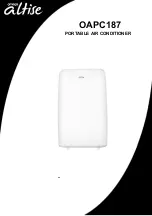
15
Air conditioning systems require a specified airflow. Each ton of cooling requires
between 350 and 450 cubic feet of air per minute (CFM), or 400 CFM nominally.
Duct design and construction should be carefully done. System performance can be
lowered dramatically through bad planning or workmanship.
Air supply diffusers must be selected and located carefully. They must be sized and
positioned to deliver treated air along the perimeter of the space. If they are too
small for their intended airflow, they become noisy. If they are not located properly,
they cause drafts. Return air grilles must be properly sized to carry air back to the
blower. If they are too small, they also cause noise.
The installers should balance the air distribution system to ensure proper quiet air-
flow to all rooms in the home. This ensures a comfortable living space.
These simple mathematical formulas can be used to determine the CFM in a resi-
dential or light commercial system.
Electric resistance heaters can use
CFM =
volts x amps x 3.414
1.08 x temp rise
Gas furnaces can use
CFM =
BTUH
∆
T x 1.08
An air velocity meter or airflow hood can give a more accurate reading of the sys-
tem CFM.
13.0 CHECKING REFRIGERANT CHARGE
Charge for all systems should be checked against the Charging Chart inside the
access panel cover. Before using the chart, the indoor conditions must be within
2°F of desired comfort conditions and system must be run until operating conditions
stabilize (15 min. to 30 min.)
IMPORTANT:
Do not operate the compressor without charge in system.
Addition of R-410A will raise pressures (vapor, liquid and discharge) and lower
vapor temperature.
If adding R-410A raises both vapor pressure and temperature, the unit is over-
charged.
IMPORTANT:
Use industry-approved charging methods to ensure proper system
charge.
13.1 CHARGING USING CHARGING CHART
NOTE: THIS UNIT CONTAINS R-410A REFRIGERANT.
DO NOT
CHARGE WITH R-22 REFRIGERANT.
The liquid pressure method is used for charging systems in the cooling mode. The
service port on the liquid (small valve) and suction (large valve) is used for this pur-
pose.
Verify that the outdoor unit is running in the cooling mode and the indoor air mover
is delivering the maximum airflow for this system size. Read and record the outdoor
ambient temperature. Read and record the liquid and suction pressures at the ports
on the liquid and suction valves.
If refrigerant lines are sized using the nameplate charge, the correct liquid pressure
is found at the intersection of the suction pressure and the outdoor ambient.
1.
Remove refrigerant charge if the liquid pressure is above the chart value.
2.
Add refrigerant charge if the liquid pressure is below the chart value.
!
CAUTION
THE TOP OF THE SCROLL COMPRESSOR SHELL IS HOT. TOUCHING THE
COMPRESSOR TOP MAY RESULT IN SERIOUS PERSONAL INJURY.
!
CAUTION
R-410A PRESSURES ARE APPROXIMATELY 60% HIGHER THAN R-22
PRESSURES. USE APPROPRIATE CARE WHEN USING THIS REFRIGER-
ANT. FAILURE TO EXERCISE CARE MAY RESULT IN EQUIPMENT DAM-
AGE, OR PERSONAL INJURY.










































